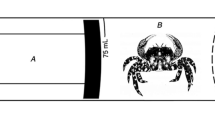Abstract
IT has been observed1 that nitrogen output in the shore crab, Carcinides, is very low prior to moulting, but begins to increase over the last few days. An indication that it rises sharply after ecdysis has now been confirmed in Asellus aquaticus (Fig. 1). Feeding individuals were isolated in 2 ml. of water at 23 ± 0.5° C.; the water was renewed daily, and its content of ammonia and amino-nitrogen (as in Carcinides the predominant nitrogen-compounds excreted) was estimated by a micro-adaptation of the Sørensen method. Estimates were monitored by the use of Russell's phenate–hypochlorite method2.
Similar content being viewed by others
References
Needham, A. E., Physiol. Comp. et Oecol. (in the press).
Russell, J. A., J. Biol. Chem., 156, 457 (1944).
Needham, A. E., J. Embryol. Exp. Morph., 3, 189 (1955).
Carlisle, D. B., and Dohrn, P. F. R., Publ. Staz. Zool. Napoli, 24, 69, 279 (1953).
Nieland, K. A., and Scheer, B. T., Physiol. Comp. et Oecol., 3, 321 (1953).
O'Farrell, A. F., and Stock, A., Austral. J. Biol. Sci., 6, 485; 7, 302, 525 (1953–54).
Needham, A. E., “Regeneration and Wound-Healing” (Methuen, London, 1952).
Author information
Authors and Affiliations
Rights and permissions
About this article
Cite this article
NEEDHAM, A. Nitrogen Output and Ecdysis in Crustacea. Nature 178, 495–496 (1956). https://doi.org/10.1038/178495a0
Issue Date:
DOI: https://doi.org/10.1038/178495a0
- Springer Nature Limited
This article is cited by
-
Effects of prolonged starvation on O2 consumption, NH 4 + excretion, and chemical composition of the bathypelagic mysid Gnathophausia ingens
Marine Biology (1983)
-
Effect of long term starvation on the biochemical composition of the muscles and hepatopancreas in the crab Menippe rumphii (Fabricius) (Crustacea: Brachyura)
Hydrobiologia (1981)





